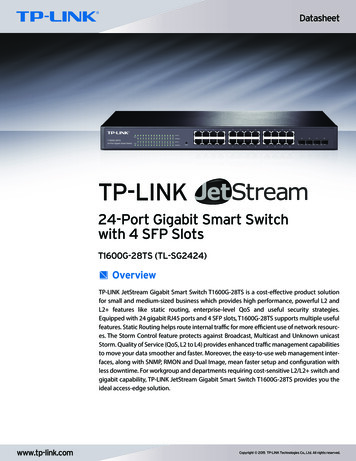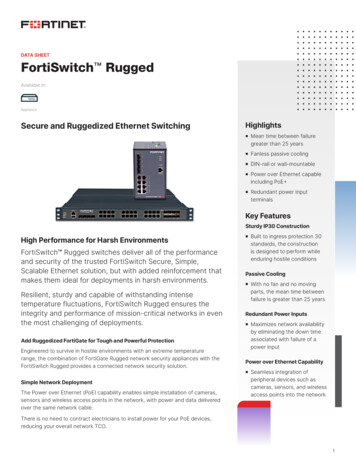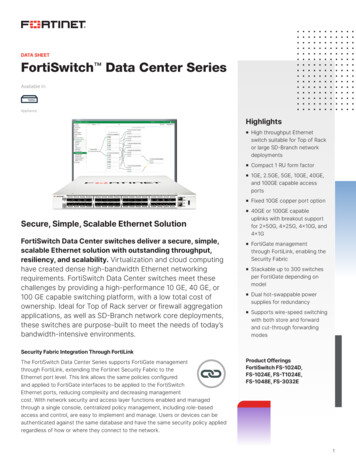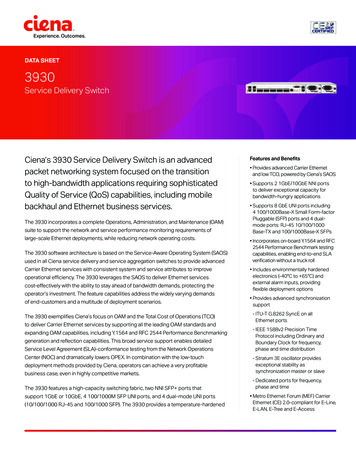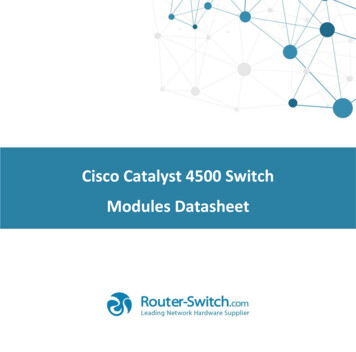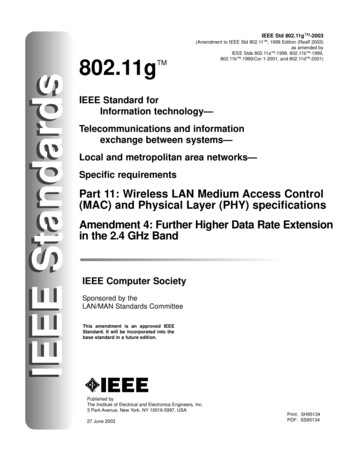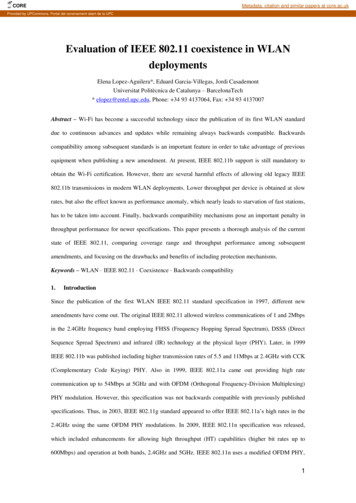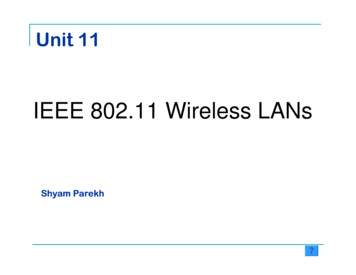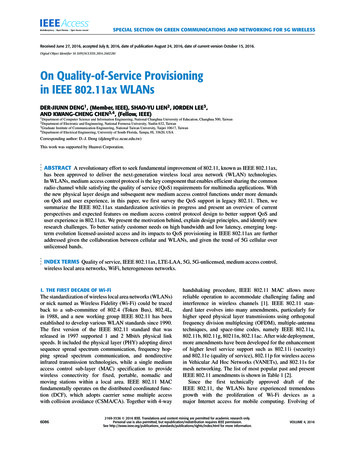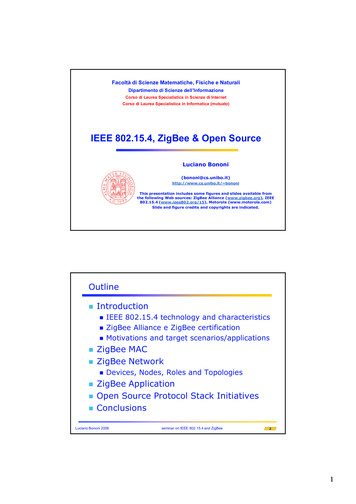
Transcription
Facoltà di Scienze Matematiche, Fisiche e NaturaliDipartimento di Scienze dell’InformazioneCorso di Laurea Specialistica in Scienze di InternetCorso di Laurea Specialistica in Informatica (mutuato)IEEE 802.15.4, ZigBee & Open SourceLuciano Bononi(bononi@cs.unibo.it)http://www.cs.unibo.it/ bononiThis presentation includes some figures and slides available fromthe following Web sources: ZigBee Alliance (www.zigbee.org), IEEE802.15.4 (www.ieee802.org/15), Motorola (www.motorola.com)Slide and figure credits and copyrights are indicated.Outline Introduction ZigBee MACZigBee Network IEEE 802.15.4 technology and characteristicsZigBee Alliance e ZigBee certificationMotivations and target scenarios/applicationsDevices, Nodes, Roles and TopologiesZigBee ApplicationOpen Source Protocol Stack InitiativesConclusionsLuciano Bononi 2006seminar on IEEE 802.15.4 and ZigBee21
IEEE 802.15.4Technology and characteristicsLuciano Bononi 2006seminar on IEEE 802.15.4 and ZigBee3The 802 Wireless SpaceWWANIEEE 802.22RangeIEEE 802.20WMANWiMaxIEEE 802.16WLANZigBee802.15.4 Bluetooth802.15.1WPAN0.010.1WiFi802.11110Data Rate (Mbps)802.15.3802.15.3a802.15.3c1001000Slide credits: ZigBee AllianceLuciano Bononi 2006seminar on IEEE 802.15.4 and ZigBee42
The Wireless MarketINTERNET/AUDIOLONGTEXT 802.11bMULTI-CHANNELDIGITAL VIDEO802.15.3/WIMEDIA802.11a/HL2 & 802.11gZigBeeSHORT RA GECOMPRESSEDVIDEOBluetooth 2Bluetooth1LOW ACTUAL THROUGHPUTLuciano Bononi 2006 HIGHseminar on IEEE 802.15.4 and ZigBee5Basic Radio CharacteristicsZigBee technology reliesupon IEEE 802.15.4, whichhas excellent performancein low SNR environmentsSlide credits: ZigBee AllianceLuciano Bononi 2006seminar on IEEE 802.15.4 and ZigBee63
IEEE 802.15.4 Frequencies and Data RatesMax power: 1mW (0 dBm)Max range: 10-75 m (up to 1500 with ZigBee Pro)*BA D COVERAGEDATA RATE# OF CHA EL(S)(5 Mhz each) (DSSS)2.4 GHzISMWorldwide250 kbpsFC (2405 5 * (ch - 11)) MHz, where ch 11, 12, ., 26.868 MHz915 MHzEuropeISM*AmericasOrthog.16QPSK20 kbps40 kbpsBPSK1BPSK10Slide credits: ZigBee AllianceLuciano Bononi 2006seminar on IEEE 802.15.4 and ZigBee7Comparison of complementary protocolsFeature(s)Application focusStack sizePower lityData RateTarget costSecurityLuciano Bononi 2006IEEE 802.11b/g/aWeb, e-mail, Mmedia 1000kBHoursVery Complexmany (IP)Enumeration upto 3seconds100 mRoaming possible11-54 Mbps (up to 108)50 EURAuthentication Service SetID (SSID)BluetoothCable replacement 250kBDaysComplex7Enumeration upto 10seconds10mNo1Mbps10 EUR64 bit, 128 bitseminar on IEEE 802.15.4 and ZigBeeZigBeeMonitoring & control 64kBYearsSimple65536 (local). Up to 2 64Enumeration 30ms70m-300mYESup to 250Kbps2 EUR128 bit AES and ApplicationLayer user defined84
How is ZigBee related to IEEE 802.15.4? ZigBee takes full advantage of a powerfulphysical radio specified by IEEE 802.15.4 ZigBee adds logical network, security andapplication software ZigBee continues to work closely with theIEEE to ensure an integrated andcomplete solution for the marketLuciano Bononi 2006seminar on IEEE 802.15.4 and ZigBee9IEEE 802.15.4 Protocol Mission 15.4 Protocol was developed for very different reasons thanBluetooth 802.15.4 Bluetooth Very low duty cycle, very long primary battery life applications as wellas mains-poweredStatic and dynamic mesh, cluster tree and star network structures withpotentially a very large number ( 65534) of client units, low latencyavailable as requiredAbility to remain quiescent for long periods of time withoutcommunicating to the networkModerate duty cycle, secondary battery operation where battery lastsabout the same as master unitWire replacement for consumer devices that need moderate data rateswith very high QoS and very low, guaranteed latencyQuasi-static star network structure with up to 7 clients (and ability toparticipate in more than one network simultaneously)Generally used in applications where either power is cycled (headsets,cellphones) or mains-powered (printers, car kits)Protocol differences can lead to tremendous optimizations inpower consumptionLuciano Bononi 2006seminar on IEEE 802.15.4 and ZigBee105
Why ZigBee? Reliable and self healingSupports large number of nodesEasy to deployVery long battery lifeSecureLow costCan be used globally Designer concentrates on end application e.g. ZigBee moduleSilicon vendors and ZigBee Alliance take care oftransceiver, RF channel and protocol stack (*)More Information ZigBee: www.zigbee.orgLuciano Bononi 2006seminar on IEEE 802.15.4 and ZigBee11ZigBee Alliance e ZigBee certificationLuciano Bononi 2006seminar on IEEE 802.15.4 and ZigBee126
What is the ZigBee Alliance? An Organization with a mission to define reliable,cost-effective, low-power, wirelessly networked,monitoring and control products based on an openglobal standard Alliance provides upper layer stack and application profiles compliance and certification testing branding Result is a set of interoperable solutionsrecognizable in the marketLuciano Bononi 2006seminar on IEEE 802.15.4 and ZigBee13Who is supporting the ZigBee Alliance? Eight promoter companies– Ember, Freescale, Honeywell, Invensys,Mitsubishi, Motorola, Philips and Samsung A rapidly growing list (Over 120participants) of industry leaders worldwidecommitted to providing ZigBee-compliantproducts and solutionsLuciano Bononi 2006seminar on IEEE 802.15.4 and ZigBee147
The ZigBee Platform and certificationPublic Application ProfileCertifiedProductZigBee StackIEEE 802.15.4CompliantPlatformSlide credits: ZigBee AllianceLuciano Bononi 2006seminar on IEEE 802.15.4 and ZigBee15ZigBee MotivationsLuciano Bononi 2006seminar on IEEE 802.15.4 and ZigBee168
need for ZigBee technology? No standard approach today that addressesthe unique needs of most remote monitoringand control applications– Enables the broad-based deployment ofreliable wireless networks with lowcomplexity, low cost solutions– Provides the ability to run for years oninexpensive primary batteries for a typicalmonitoring application– Capable of inexpensively supporting robustmesh networking technologiesLuciano Bononi 2006seminar on IEEE 802.15.4 and ZigBee17Advantages of ZigBee vs. proprietary solutions? Product interoperabilityVendor independenceIncreased product innovation as a result ofindustry standardizationA common platform is more cost effective thancreating a new proprietary solution from scratchevery timeCompanies can focus their energies on findingand serving customersHow is Open Source intended in this vision?Slide credits: ZigBee AllianceLuciano Bononi 2006seminar on IEEE 802.15.4 and ZigBee189
ZigBee:Examples of target scenarios/applicationsLuciano Bononi 2006seminar on IEEE 802.15.4 and ZigBee19802.15.4 Application Space Sensors & Controls: Home Automation Industrial Automation Remote Metering Automotive Networks Interactive Toys Active RFID/ asset tracking Medical .and moreSlide credits: ZigBee AllianceLuciano Bononi 2006seminar on IEEE 802.15.4 and ZigBee2010
Sensor/Control Network Requirements Large networks (large number of devices andlarge coverage area) can form autonomously operate very reliably for years without any operatorintervention Very long battery life (years off of a AA cell) very low infrastructure cost (low device &setup costs) and very low complexity and smallsize Device data rate and QoS needs are low (*) Standardized protocols are necessary to allowmultiple vendors to interoperateLuciano Bononi 2006seminar on IEEE 802.15.4 and ZigBee21Applications fieldsecurity(heating.) HVAC(metering) AMRlighting controlaccess ePERSONALHEALTH CAREasset mgtprocesscontrolenvironmentalenergy mgtWireless Control thatSimply WorksINDUSTRIALCONTROLPC ekeyboardjoysticksecurityHVAClighting controlaccess controllawn & garden irrigationSlide credits: ZigBee AllianceLuciano Bononi 2006seminar on IEEE 802.15.4 and ZigBee2211
ZigBee Application classes and traffic typesZigBee networks can support different traffic: Periodic data Intermittent data E.g. wireless sensors and metering applicationsbeaconing principle: scheduled wakeup time send sleepE.g. wireless light switchBeaconless system: device attach to network only uponneed, and sleep o.w.Repetitive (low latency) data E.g. security systemsGuaranteed Time Slot (GTS) capability: a MAC superframestructure managed by network coordinator for QoS-basedscheduling of reserved slots within fixed latency limits (nocontention)Luciano Bononi 2006seminar on IEEE 802.15.4 and ZigBee23Application examples: Lighting Control Advance Transformer Wireless lighting control Light switches anywhereCustomizable lightingschemesEnergy savings on brightdaysExtendable networks Additional sensorsOther networksSlide credits: ZigBee AllianceLuciano Bononi 2006seminar on IEEE 802.15.4 and ZigBee2412
HVAC Energy Management Hotel energy management Major operating expense forhotel Centralized HVACmanagement allow hoteloperator to make sure emptyrooms are not cooledRetrofit capabilitiesBattery operated t-stats canbe placed for conveniencePersonalized room settings atcheck-inSlide credits: ZigBee AllianceLuciano Bononi 2006seminar on IEEE 802.15.4 and ZigBee25Asset Management Within each container, sensors form a mesh network.Multiple containers in a shipform a mesh to report sensordataIncreased security through ontruck and on-ship tamperdetectionFaster container processing.Manifest data and sensor dataare known before ship docks atport.Slide credits: ZigBee AllianceLuciano Bononi 2006seminar on IEEE 802.15.4 and ZigBee2613
Residential ControlSlide credits: ZigBee AllianceLuciano Bononi 2006seminar on IEEE 802.15.4 and ZigBee27System Simplicity and Flexibility (example)RF Packet Radio8-Bit MCUSlide credits: MotorolaLuciano Bononi 2006seminar on IEEE 802.15.4 and ZigBee2814
ZigBee (and IEEE 802.15.4)Protocol Stack:General conceptsUseful link: ciano Bononi 2006seminar on IEEE 802.15.4 and ZigBee29ZigBee 1.0: (static) tree network structureSlide credits: ZigBee AllianceLuciano Bononi 2006seminar on IEEE 802.15.4 and ZigBee3015
ZigBee Pro: (dynamic) Mesh NetworkingSlide Courtesy ofLuciano Bononi 2006seminar on IEEE 802.15.4 and ZigBee31ZigBee Mesh Networking exampleSlide Courtesy ofLuciano Bononi 2006seminar on IEEE 802.15.4 and ZigBee3216
ZigBee Mesh Networking exampleSlide Courtesy ofLuciano Bononi 2006seminar on IEEE 802.15.4 and ZigBee33ZigBee Mesh Networking exampleSlide Courtesy ofLuciano Bononi 2006seminar on IEEE 802.15.4 and ZigBee3417
ZigBee Mesh Networking exampleSlide Courtesy ofLuciano Bononi 2006seminar on IEEE 802.15.4 and ZigBee35ZigBee Device Types ZigBeeNetwork Coordinator (ZNC) Oneand only one required for each ZB network. Initiates network formation. Acts as 802.15.4 2003 PAN coordinator (FFD). May act as router once network is formed. ZigBeeNetwork Router (ZNR) Optionalnetwork component.associate with ZNC or with previouslyassociated ZNR. Acts as 802.15.4 2003 coordinator (FFD). Participates in multihop routing of messages. May ZigBeeEnd Device (ZED) Optionalnetwork component.not allow association. Shall not participate in routing. ShallLuciano Bononi 2006seminar on IEEE 802.15.4 and ZigBeeSlide credits: ZigBee Alliance3618
ZigBee Network TopologiesMeshStarPAN coordinatorCluster TreeFull Function DeviceReduced Function DeviceSlide credits: ZigBee AllianceLuciano Bononi 2006seminar on IEEE 802.15.4 and ZigBee37Network Structure (association)Slide credits: ZigBee AllianceLuciano Bononi 2006seminar on IEEE 802.15.4 and ZigBee3819
Network StructureSlide credits: ZigBee AllianceLuciano Bononi 2006seminar on IEEE 802.15.4 and ZigBee39Network StructureSlide credits: ZigBee AllianceLuciano Bononi 2006seminar on IEEE 802.15.4 and ZigBee4020
Cluster Tree Networks Cluster tree networks enable a peer-peernetwork to be formed with a minimumof routing 2210CH6“Parent”“Child”Links indicate familial relationship, not communications capabilitySlide credits: ZigBee AllianceLuciano Bononi 2006seminar on IEEE 802.15.4 and ZigBee41Cluster Tree Networks Employ multi-hop routing (table driven) AODV considered for dynamic routing inMeshesCan be very large: 255 clusters of 254nodes each 64,770 nodesMay span physically large areasSuitable for latency-tolerant applicationsSlide credits: ZigBee AllianceLuciano Bononi 2006seminar on IEEE 802.15.4 and ZigBee4221
Protocol Stack Features 8-bit microcontroller(e.g. 80c51)Compact protocolstackSupports even simplerslave-only stackAPPLICATION/PROFILESZigBee or OEMAPPLICATION ormMAC LAYERPHY LAYERIEEEApplicationZigBee Platform StackSlide credits: ZigBee AllianceLuciano Bononi 2006Siliconseminar on IEEE 802.15.4 and ZigBee43IEEE 802.15.4Protocol Stack:Phy and MAC layersLuciano Bononi 2006seminar on IEEE 802.15.4 and ZigBee4422
What IEEE 802.15.4 AddressesUpper Layer StackOther LLCIEEE 802.2 LLC IEEE 802.15.4 IEEE 802.15.4 MACMAC and PHY onlyIEEE 802.15.4868/915 MHz PHYIEEE 802.15.42400 MHz PHYSlide credits: ZigBee AllianceLuciano Bononi 2006seminar on IEEE 802.15.4 and ZigBee45ZigBee Channel Access OptionsTwo channel access mechanisms: Non-beacon network A simple, traditional multiple access system used in simplepeer and near-peer networksStandard ALOHA CSMA-CA communicationsPositive acknowledgement for successfully receivedpacketsBeacon-enabled network Superframe structure- network coordinator transmitsbeacons at predetermined intervalsDedicated bandwidth and low latencyLow Power Consumption mode for CoordinatorSlide credits: ZigBee AllianceLuciano Bononi 2006seminar on IEEE 802.15.4 and ZigBee4623
IEEE 802.15.4 MAC channel access in one slide Example of superframe structure (optional) and basiccontention-based MAC access schemeBeacon i 1 (ZNC)Beacon i (ZNC)Contention-basedGTS1GTS2timePacket TransmittedMedium BusyackImplicit reserv.Guard TimeLuciano Bononi 2006Back-offWindowGuard Timeseminar on IEEE 802.15.4 and ZigBee47Other Benefits of Beacon Mode Beacon Mode A very powerful mechanism for controlling powerconsumption in extended networks like cluster tree ormeshAllows all clients in a local piece of the network theability to know when to communicate with each otherPAN has a coordinator that manages the channel andarranges the callsSignificant value will be in system power consumptionfor networks which are primarily battery poweredSlide credits: ZigBee AllianceLuciano Bononi 2006seminar on IEEE 802.15.4 and ZigBee4824
ZigBee – Highly Reliable Mesh and tree networking protocol providesredundant pathsAutomatic retries and acknowledgementsBroadcast delivery scheme ensures reliablebroadcasts across the networkParents keep track of messages for sleepingchildrenHigh intrinsic interference tolerance Multiple channelsFrequency agilityRobust modulationSlide credits: ZigBee AllianceLuciano Bononi 2006seminar on IEEE 802.15.4 and ZigBee49ZigBee – Highly Secure Utilizes AES 128-bit encryptionConcept of a “trust center”Link and network keysAuthentication and encryptionSecurity can be customized for theapplicationKeys can be “hard-wired” intoapplicationSlide credits: ZigBee AllianceLuciano Bononi 2006seminar on IEEE 802.15.4 and ZigBee5025
IEEE 802.15.4 MAC summarized Employs 64-bit IEEE & 16-bit short addresses Two (physical) devices specified Full Function Device (FFD)Reduced Function Device (RFD)Three (logical) device roles specified: Up to 264 nodes (more than we’ll probably need )local addressing, simple networks (65,000 nodes 2 16)ZigBee Network Coordinator (ZNC)ZigBee Network Router (ZNR)ZigBee End Node (ZED)Simple frame structureReliable delivery of data (ACK)Association/disassociationAES-128 securityDistribued CSMA-CA channel access (basic access mode)Optional superframe structure with beacons: GTS mechanismLuciano Bononi 2006seminar on IEEE 802.15.4 and ZigBee51ZigBee Pro is Mesh NetworkingZigBee Coordinator (FFD)ZigBee Router (FFD)ZigBee End Device (RFD or FFD)Mesh LinkStar LinkSlide credits: ZigBee AllianceLuciano Bononi 2006seminar on IEEE 802.15.4 and ZigBee5226
Basic etwork Characteristics 65,536 network (client) nodes Optimized for timing-criticalapplications– Network join time:30 ms (typ)– Sleeping slave changing toactive: 15 ms (typ)– Active slave channel accesstime: 15 ms (typ)Network coordinatorFull Function nodeReduced Function nodeCommunications flowVirtual linksSlide credits: ZigBee AllianceLuciano Bononi 2006seminar on IEEE 802.15.4 and ZigBee53ZigBee Stack componentsCommunication Protocol library IEEE 802.15.4 Phy & Mac ZigBee Networking Layer Application Framework Security Cross-functions HAL: hardware abstraction layer OS-like functionalitiesLuciano Bononi 2006seminar on IEEE 802.15.4 and ZigBee5427
IEEE 802.15.4/ZigBee ArchitectureAFSSP-SAPNode ManagerEndPoint 0APSDE-SAPMessage BrokerApplication SupportMapping TablesSecurity ManagerSubLayer APSBinding TablesNLDE-SAPSecurity Manager etwork LayerRouting TablesMessage Broker WKRouting ManagerMCPS-SAPNLME-SAPService SecurityEndPoint NAPSDE-SAPSecurity ManagerAPSME-SAPProvider: SSP ZDODiscovery ManagerAPLApplicationObjectNBinding ManagerZDO Management PlaneEndPoint 1APSDE-SAP ZigBee Device ObjectNetwork ManagerApplication LayerApplicationObject1PublicInterfaceApplication FrameworkMLME-SAPMAC: Medium Access Control LayerPD-SAP868/915 MHz2.4 GHzPLME-SAPHALOSPHY: Physical LayerSlide credits: STMicroelectronicsLuciano Bononi 2006seminar on IEEE 802.15.4 and ZigBee55ZigBee Stack “iper-space” (dimensions) Depending on Topology/features ZigBee stack: Tree-based (static case), ZigBee Pro stack: Mesh-based (dynamic case)Depending on functionalities ZigBee Standard Standard proprietary extensionDepending on Nodes’ type (and Responsibilities) FFD (routing capabilities) RFD (simple, end devices)Resources (Energy) Sleepy vs Non Sleepy Mobile vs quasi-staticSlide credits: STMicroelectronicsLuciano Bononi 2006seminar on IEEE 802.15.4 and ZigBee5628
IEEE 802.15.4 PHY/MAC basics802.15.4 is a simple packet data protocolfor lightweight wireless networks 3 ISM bands, 27 channels specifiedChannel Access CSMA/CA slotted and unslottedSupport for Message Acknowledgement,optional Beacon and Guaranteed TimeSlotsMulti-level securitySlide credits: STMicroelectronicsLuciano Bononi 2006seminar on IEEE 802.15.4 and ZigBee57IEEE 802.15.4 ArchitectureApplication FrameworkTCP/IPZigBee WK802.2 LLCService Specific Convergence Sub-layer Channel Access PAN Maintenance Reliable Data Link RF transceiver Low-level controlSSCSMCPS-SAPMLME-SAPMAC: Medium Access Control LayerPD-SAP868/915 MHz2.4 GHzPLME-SAPPHY: Physical LayerSlide credits: STMicroelectronicsLuciano Bononi 2006seminar on IEEE 802.15.4 and ZigBee5829
Services and Primitives For confirmed service,4 primitive’s types:1)2)3)4) request – higher entityasks for some serviceindication - entity isinformed about event orremote service requestresponse - entity toresponds toevent/requetsconfirm - entity isinformed about itsrequest statusFor unconfirmed service,only the first 2 types.Apply to all Layers.Slide credits: STMicroelectronicsLuciano Bononi 2006seminar on IEEE 802.15.4 and ZigBee59IEEE 802.15.4 PHY: Functionalities TX/RX packets (PPDU) across physical mediumActivation/deactivation of the radio transceiverClear channel assessment (CCA)Energy detection (ED)Link quality indication (LQI)Channel selectionPrimitivesDescriptionPD-DATATransmitting/ receiving packetsPLME-GETGetting PHY PAN information baseReqConfXXPLME-SETSetting PHY PAN information basePLME-SETTRX-STATEActivation/deactivation of the radiotransceiverXXPLME-CCAClear channel assessmentXXPLME-EDEnergy detection (ED)XXRespIndicXSlide credits: STMicroelectronicsLuciano Bononi 2006seminar on IEEE 802.15.4 and ZigBee6030
MAC responsibilities MAC Data services enables MPDU exchange with PHY dataserviceMAC Management services Association/DisassociationOrphaning and Sync with parent nodeBeacon ManagementFrame validationFrame delivery ACKHooks up with security mechanismsSlide credits: STMicroelectronicsLuciano Bononi 2006seminar on IEEE 802.15.4 and ZigBee61IEEE 802.15.4 Security Security modes Unsecured modeACL modeSecured modeSecurity Services Access ControlData EncryptionFrame IntegritySequential FreshnessSlide credits: STMicroelectronicsLuciano Bononi 2006seminar on IEEE 802.15.4 and ZigBee6231
NWK LayerAPL Structure/FunctionalitiesResponsibilitiesSSP AFNWK LayerReference model NLDE: Data serviceNLME: Management servicesAPSZDO NWKMACPHYSlide credits: STMicroelectronicsLuciano Bononi 2006seminar on IEEE 802.15.4 and ZigBee63NWK Layer responsibilities Starting a network Joining and leaving a network the ability to successfully establish a newnetwork.the ability to gain (join) or relinquish (leave)membership to a node of the network.Configuring a new device the ability to sufficiently configure the stack foroperation as required.Slide credits: STMicroelectronicsLuciano Bononi 2006seminar on IEEE 802.15.4 and ZigBee6432
NWK Layer responsibilities (cont)Addressing the ability of a ZBC to assign shortaddresses (16 bits) to devices joining the network.Routing rightful node/route discovery& maintenance operations routing frames to their intended destinations store of pertinent neighbor informationSecurity applying security to outgoing frames and removingsecurity to terminating framesSlide credits: STMicroelectronicsLuciano Bononi 2006seminar on IEEE 802.15.4 and ZigBee65Routing: device’s responsibilities Mandatory functionalities for both ZBC and ZBR: Relay DATA frames on behalf of higher layers and/or other ZBRs. Participate in route discovery in order to establish routes forsubsequent DATA frames and/or on behalf of end devices. Participate in end-to-end and local route repair. Employ the ZigBee path cost metric as specified in routediscovery and route repair.Optional functionalities for both ZBC and ZBR: Maintain routing tables in order to remember best availableroutes. Initiate route discovery on behalf of higher layers and/or of otherZBR. Initiate end-to-end route repair. Initiate local route repair on behalf of other ZigBee routers.Slide credits: STMicroelectronicsLuciano Bononi 2006seminar on IEEE 802.15.4 and ZigBee6633
Tree (1.0) vs Mesh (Pro) StackTree Stack“ZigBee”FeatureMesh Stack“ZigBee Pro”ZigBee Stack ProfileHCL: HW comp. listZigBeeZigBee ProZigBee application profilesHA: home automationHA, CBA (commercial Buidling),IPM (industrial plant monitoring.WSA.Messaging modelZigBee APS messageswith fragmentationAPS messages with(Uni-Multi-Broad)-castRouting methodTree or MeshMesh only (table driven)Addressing methodDistributed Hierarchical(tree based)Distributed alternative method(stochastic)BindingsCentralized: stored onCoordinator or source storageSource onlyAsymmetric LinksNo detectionDetected and avoidedZigBee End DevicesSleepy ZED supportedSleepy, Mobile ZEDs supportedLarge sensor networks(100 devices)Not supportedSingle-step route establishmentback to data gatewaySlide credits: STMicroelectronicsLuciano Bononi 2006seminar on IEEE 802.15.4 and ZigBee67The Application LayerAPLAFSSPAPS APS: Application Support sub-layerAPS ZDO: ZigBee Device ObjectZDOMAC AF:AF Application FrameworkPHYZDOComponents:ComponentsNWKthe manufacturer-defined application objects ZigBee Application Profiles ZDP: ZigBee Device Profile Per Application segment (HA, CBA, IPM, WSA, )Slide credits: STMicroelectronicsLuciano Bononi 2006seminar on IEEE 802.15.4 and ZigBee6834
ZigBee ProfilesGeneralities: 3 classes: private, public or publishedIdentifier has to be unique (assigned by the Alliance).Defined ZigBee profiles ZDP: ZigBee Device Profile (private)ZAP: ZigBee Application Profile (public) HCL (obsolete), HA, CBA, IPM, WSA, ZCL: ZigBee Cluster Library Device and Cluster descriptions are independent fromProfile IdentifiersService types (KVP or MSG) Replaced by ZCLSlide credits: STMicroelectronicsLuciano Bononi 2006seminar on IEEE 802.15.4 and ZigBee69APS Sub-layerAPLAFResponsibilitiesServicesAPS SSPAPS Sub-LayerReference model APSDE: Data serviceAPSME: Management servicesZDO NWKMACPHYSlide credits: STMicroelectronicsLuciano Bononi 2006seminar on IEEE 802.15.4 and ZigBee7035
APS Sub-layerAPLmaintaining tables for binding (the ability to match 2 devices togetherbased on their services and their needs)forwarding messages betweenbound devicesAPSZDO SSPAFAPS responsibilities NWKMACPHYIts services are used by the ZDO Manufacturer-defined Application ObjectsSlide credits: STMicroelectronicsLuciano Bononi 2006seminar on IEEE 802.15.4 and ZigBee71APSME: APS Management EntityManagement services Functionalities Binding Multicast Endpoint groups management Single address shared by multiple sub-units (applicationobjects).Information management The ability to match 2 devices together based on theirservices and their needs.To provide to read/write the value of an attribute from theAIB, Mapping/Binding tables, and Multicast Group tablesSecurity The ability to set up authentic relationships with otherdevices through the use of secure keys.Slide credits: STMicroelectronicsLuciano Bononi 2006seminar on IEEE 802.15.4 and ZigBee7236
ZigBee Device Object: ZDOZDO Layer ResponsibilitiesStructure AFManager & Configuration AttributesZDP: ZigBee Device Profile Client ServicesServer ServicesAPSZDO APLSSP NWKMACPHYSlide credits: STMicroelectronicsLuciano Bononi 2006seminar on IEEE 802.15.4 and ZigBee73ZigBee Device Object: ZDOZDO responsibilities: Defining the role of the device Coordinator, Router, End DeviceAPLAFAPSZDO It’s a special application which employsNWK and APS primitives to implementZBC, ZBR, ZEDSSP NWKMAC Initialize APS, NWK, SSP Devices & Service Discovery Initiating and/or responding to binding requests Establishing a secure relationship between networkdevicesPHYSlide credits: STMicroelectronicsLuciano Bononi 2006seminar on IEEE 802.15.4 and ZigBee7437
ZDO: structure ZDO structure: 1Configuration Attributes Object(the .ini file for ZigBee devices) 5Manager Objects:Mandatory Device and Service Discovery Network Manager Binding Manager Security Manager Node ManagerOptional Itpresents Public interfaces to the Application objects inthe AF layer for control of device and network functionsSlide credits: STMicroelectronicsLuciano Bononi 2006seminar on IEEE 802.15.4 and ZigBee75ZDO: Device and Service Discovery Device discovery (other ZigBee device by query) IEEE address requests NWK address requests Unicast, the NWK address is knownBroadcast, the IEEE address is knownService discovery Discovery of the services available on endpoints By query for each endpoint on a given deviceBy using a match service feature (broadcast or unicast)By having devices announce themselvesUtilizes the complex, user, node, or power descriptorsSlide credits: STMicroelectronicsLuciano Bononi 2006seminar on IEEE 802.15.4 and ZigBee7638
Application Framework: AFAF responsibilities APS functions used AFAddressed by an Endpoint numberData services By using the new ZCL Superseded KVP & MSGAPSZDO APLHosting for the application objectsSSP NWKMACZDO Functions used via the Public Interface Control and management of the protocol layersin the ZigBee device Initiation of standard network functionsPHYSlide credits: STMicroelectronicsLuciano Bononi 2006seminar on IEEE 802.15.4 and ZigBeeAvailable ZigBee Stack (v.1.0)77(old versions)CompanyStack nameMAC ver.EmberEmberZNet2.x.0integratedPlatform usedTI/ChipconF8W Z-Stack1.0-1.3.00.71 - 1.3TI 2420TI 2430-2431FreescaleZ-Stack 1.01.2.2v.1.063MC 13192-13193Old stack from F8WProbably not supportedHCS08/MC13192for FreescaleMindteckBeeStack v.1.0Integration UKCompXsZigBee Stackv.1.25AirBeeZNS 0.92NAInstitute forInformation Ind.-JPIII Zigbee Adv.ProtocolNAv3 / 1.0CC2420DBJN5121 / UZ2400DBKfor its own testfor Jennic / UbecHelicommHelicomm Stackv.0.9.05Helicommv.1.0iPLink EZDKAlso for SilabsSilicon LabOki ML7065-032KorwinWiniZB v.1.0Atmel128 CC2420Renesas (RTA)Renesas ZBv.0.97M16C MC13192M16C CC2420NASlide credits: STMicroelectronicsLuciano Bononi 2006seminar on IEEE 802.15.4 and ZigBee7839
Available non-ZCPCompanyStack nameMicrochipZigBee PicDemAtalumGreenMesh(zigbee certified platform)MAC ver.ZigBee Stack (v.?)Platform usedPicDemZNO ZCPNO ZCPCrossbowBMUbiWaveUbiNetAtmelMeshnetics(ex LuxoftLabs)ZigBeeNetUnder developmentwith RenesasMitsubishi (MERL)Dust NetworksArchRockOne-RF Technology?OpenBeeOpenBee?Available from Q4-06FreewareSlide credits: STMicroelectronicsLuciano Bononi 2006seminar on IEEE 802.15.4 and ZigBee79ZigBeeOpen Source protocol stack initiatives just old examples, more recentplatforms are provided as experimentallab, based on Freescale MC1322x (ARM7) and ATMEL (ATxmega256A3)Luciano Bononi 2006seminar on IEEE 802.15.4 and ZigBee8040
Zigbee Projects on SourceForgeNameDescriptionLanguageOpenBeeGPL, 12/2005 Hw dev. kitDesign of an IEEE 802.15.4 compliantsoftware, target independentCOpenZigLGPL, 06/2006Open source ZigBee and 802.15.4 stackOpen Source (Atmel platform?)ZigBuzzGPL, 01/2005“Implementation of Zigbee Phy, MAC,network, security and Application Stackon the Linux kernel 2.6.x”Linux WirelessSensor LANProjectGPL, 01/2005“Drivers and utility set for 802.15.4standard low-rate wireless personal areanetworking”HomeRun 0.2.110/2006Control and automation software for thehome environment, multi-channel andmulti-protocol (including Zigbee)JavaOpen-zbAFL (academicfree), 10/2006Implementation of IEEE 802.15.4 in nesCfor TinyOS and Crossbow Micaz motesFreakZA GPL v2 open source Zigbee protocolstack.C(10/
Corso di Laurea Specialistica in Informatica (mutuato) IEEE 802.15.4, ZigBee & Open Source LucianoBononi2006 seminaronIEEE802.15.4andZigBee 2 . Data Rate 11-54 Mbps (up to 108) 1Mbps up to 250Kbps Target cost 50 EUR 10 EUR 2 EUR . HVAC Energy Management Hotel energy management Major operating expense for hotel Centralized HVAC

